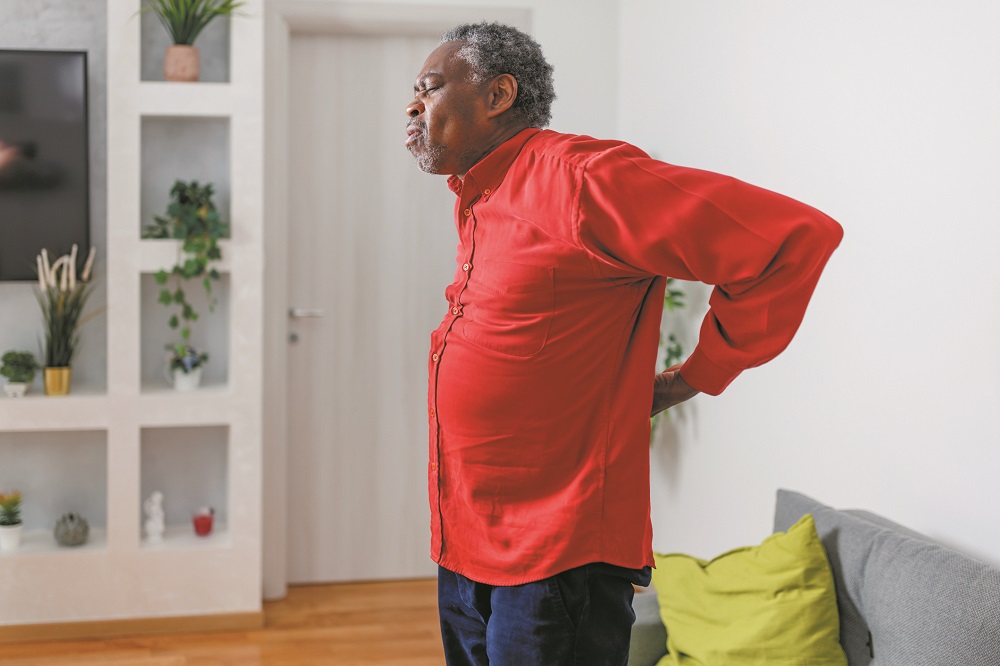Back problems are incredibly common, striking people of all ages. There are a multitude of causes of back pain, from sprains and strains to degenerative disks, inflammatory conditions, osteoporosis, and more. While no strategy can guarantee that you’ll never develop back pain, there are a few tried and true guidelines that will reduce your risk, says Mara Vucich, DO, from the Maryland Spine Center at Mercy Medical Center.
1. Maintain a healthy weight. Back pain is more common in people who are overweight. Excess weight puts pressure on our bones, joints, cartilage, ligaments, tendons, and muscles. Studies show that people who are overweight have higher rates of degenerative disk disease as well as systemic chronic inflammation that may contribute to or worsen pain.
2. Exercise regularly. When it comes to a healthy back, there are two types of exercises to prioritize: low-impact aerobic exercises and core-strengthening strategies.
Aerobic exercise increases the blood flow and nutrients to the soft tissues in the back, which promotes healing and reduces stiffness. Exercise can also reduce the sensation of pain by increasing the production of pain-fighting endorphins. For the most protection, get your heart pumping with a low-impact activity like walking, biking, swimming, or using an elliptical machine. Jogging and running put extra force on the spine, which could increase pain. Aim for 150 minutes (such as 30 minutes per day for five days) of moderate-intensity activity each week.
Core strengthening protects your back by building support all the way around your midsection. The core includes several muscle groups: In the front, there’s the rectus abdominis (what you think of as “abs”) and the deeper transverse abdominis. On the sides, you have internal and external obliques. In your back lie the erector spinae and multifidi. The core also includes the diaphragm, pelvic floor, hip flexors, and gluteal muscles. There are several simple core exercises you can do at home.
- Planks: Kneel on all fours. Pull in your abdomen and move your feet back until your legs are straight. Keep your neck straight and your hands directly under your shoulders. Hold your abdomen and legs tight, and keep your back straight so it’s not sagging or lifting. (You can use a mirror to check your position.) To make the exercise easier, lower your knees. To make it more challenging, rest your forearms on the ground. Hold for 30 seconds. If that’s too long when you start, do what you can and work your way up to that time. Make sure you breathe.
- Alternating leg extensions: Kneel on all fours. Tighten your abdominal muscles and reach one arm out in front of you. Then extend the opposite leg behind you. Repeat on the other side for a total of 10 repetitions on each side.
- Bent knee raises: Lie on your back, with your knees bent. Tighten your abdominal muscles and lift one leg a few inches from the floor. Return to the starting position and switch sides. Aim for 10 repetitions per side.
It’s important to use what’s called good form when doing any exercise. If you’re new to exercise—or just want a refresher—a physical therapist can help you master using safe and correct positions. If you go to a gym, a personal trainer can help as well, but they don’t have the same kind of training that a physical therapist does.
3. Avoid smoking. Smokers have more low back pain and more degenerative disk disease in the lumbar spine than nonsmokers. A 2016 study found that the prevalence of back pain was 23.5 percent in never smokers, 33.1 percent in former smokers, and 36.9 percent in current smokers. Smoking impairs the delivery of oxygen-rich blood to your bones and tissues.
4. Avoid heavy lifting. If you don’t have to lift something heavy, don’t risk it. But when it’s unavoidable, lift with your legs, not your back. That means bending at the hips and knees instead of rounding your back to lean forward. Tighten your core muscles and hold the object you’re lifting close to your belly button. Avoid twisting while lifting.
5. Avoiding repetitive bending and twisting. If you’re working on a task that requires bending or twisting, look for either tools or techniques to reduce those motions. For example, if you’re working in the garden, instead of bending, sit with your legs folded under you or use a little stool. When bending, tighten your core muscles and bend through the hips—like a hinge—instead of rounding your back.
Causes of Back Pain
- Spinal stenosis. This occurs when the combination of disk degeneration and arthritis narrow the canal or openings that nerves travel through. Leg pain, numbness, or weakness are often worse than back symptoms. Position changes may provide temporary relief.
- Muscle or ligament strain. Sudden movement or repeated heavy lifting can strain back muscles and spinal ligaments.
- Bulging or herniated disks. Disks act as cushions between the bones in the spine. If they bulge or herniate, they can press on a nerve and cause pain.
- Arthritis. Osteoarthritis can affect the lower back and, in some cases, contribute to spinal stenosis.
- Osteoporosis. When bones become porous and brittle, the vertebrae can develop painful breaks.
- Ankylosing spondylitis. An inflammatory disease, AS can cause some of the bones in the spine to fuse, causing pain and stiffness.
- Sciatica. This nerve pain travels through the buttocks into the leg.
- Desk work. If you work at a desk all day, poor posture and sitting for too long can cause back pain. To reduce risk, sit up straight and don’t slump your shoulders. Keep your ears over your shoulders, shoulders over your hips, and hips over your ankles. Take frequent breaks to stand and walk.


